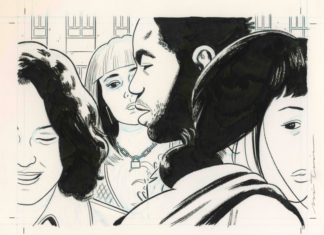Chaque 5 novembre, l’Angleterre commémore la Fawkes Night. Une nuit qui célèbre le sauvetage du roi par des feux d’artifices et l’immolation d’effigies qui représentent Guy Fawkes.
Le 5 novembre 1605, le parlement anglais fut littéralement assis sur un tonneau d’explosifs. La conspiration des poudres organisée par un groupe de catholiques anglais avait pour objectif d’assassiner le roi Jacques Ier et de destabiliser les autorités protestantes. Etant membre du complot, Guy Fawkes fut arrêté alors qu’il gardait les explosifs dans les bas-fonds de la Chambre des lords.
Pour célébrer cet échec, des feux furent allumés autour de Londres. Guy Fawkes fut exécuté, brûlé symboliquement chaque 5 novembre par le peuple anglais- Tradition qui ne semble pas terminer de sitôt.
Entretien avec l’historienne L.A. Mackay.
Quelle est la situation entre les Catholiques et les Protestants aux XVI-XVIIème siècles en Angleterre ?
C’est à partir du règne d’Henri VIII que la religion a été changée en Angleterre. C’est avec la décision du Pape de ne pas accepter le divorce d’Henri avec sa première épouse, Catherine d’Aragon. Le roi d’Angleterre s’est épris d’Anne Boleyn mais celle-ci refusait de partager son lit avec lui jusqu’à qu’il soit divorcé. Anne Boleyn était très dévote. Elle avait une forte personnalité et savait ce qu’elle voulait. Elle donna à Henry un livre écrit par William Tyndale. Au XVIIème siècle, il était illégal de posséder cet ouvrage puisqu’il s’agissait d’un manifeste pour l’émergence d’une nouvelle religion. Une religion qui n’exigeait pas à ses fidèles de se rendre à l’église pour le culte. En donnant ce livre à Henry, Anne Boleyn savait que le roi pourrait se laisser convaincre d’abandonner l’Église catholique et fonder une nouvelle. Henry a ensuite mis en place la Church of England et s’est fait chef de cette Église.
Les Catholiques se sont sentis abandonnés et les sujets du roi n’ont pas eu d’autre choix de changer de religion. Cependant, Henry suivait toujours les préceptes de la religion catholique malgré ses décisions. Il avait été jusqu’à dissoudre les monastères de son royaume.
Après la mort d’Henry, le 28 Janvier 1547, son héritier Edouard VI devint roi et suivit les traces de son père. Cependant, il ne vécut qu’à l’âge de 15 ans mais, souhaitant que la  Church of England conserve son statut de religion d’état, Edouard fit de sa cousine Lady Jane Grey, reine. Elle est désignée comme « la reine de 9 jours » ayant le règne le plus court de toute l’histoire du Royaume Uni. Lorsque Marie, la fille aînée d’Henri VIII eut vent que Lady Jane avait prendre le pouvoir, forma sa propre armée pour s’emparer du trône d’Angleterre. 9 jours plus tard, Lady Jane Grey était renversée.
Church of England conserve son statut de religion d’état, Edouard fit de sa cousine Lady Jane Grey, reine. Elle est désignée comme « la reine de 9 jours » ayant le règne le plus court de toute l’histoire du Royaume Uni. Lorsque Marie, la fille aînée d’Henri VIII eut vent que Lady Jane avait prendre le pouvoir, forma sa propre armée pour s’emparer du trône d’Angleterre. 9 jours plus tard, Lady Jane Grey était renversée.
Marie fut élevée par son père Henri VIII et sa première épouse, Catherine. Elle était aussi une Catholique dévouée et restaura rapidement le Catholicisme en Angleterre. Il est également dit qu’elle aurait tué plus de 300 protestants en les brûlant au bûcher.
Marie a développé un cancer de l’estomac et est morte le 17 novembre 1558. Sa demi-soeur Elizabeth l’a alors remplacée en tant que reine. Elizabeth était la fille d’Henry VIII et de sa seconde épouse Anne Boleyn. Elle était l’opposée totale de Marie. Elevée en tant que Protestante, la nouvelle reine restaura la Church of England et se proclama cheffe suprême de l’Eglise. Elizabeth aurait assassiné beaucoup de Catholiques, comme sa demi-soeur avait tué de Protestants. Cependant, ils n’ont pas été envoyés au bûcher mais pendus et écartelés. Elizabeth a également restauré le serment d’allégeance et l’Acte de suprématie.
La reine Elizabeth Ière n’a pas eu d’enfant et lorsqu’elle décéda, le titre de roi fut donné à son cousin Jacques, sixième du nom en Écosse. Il devint alors Jacques Ier d’Angleterre. C’est à ce moment-là que la monarchie a régné à la fois sur l’Angleterre et l’Écosse.
Après ce résumé, vous pouvez constater le degré de confusion qui régnait sur le royaume au sujet de la religion. La grande majorité des personnes nées sous Henri VIII étaient des catholiques convaincus et beaucoup d’entre eux n’éprouvaient pas le besoin d’honorer le monarque comme chef religieux plutôt que le pape.
La reine Elizabeth incitait ses sujets à ne plus venir dans les églises catholiques et a fini par interdire les prêches des prêtres jésuites. S’ils étaient pris, ils étaient exécutés.
Pensez-vous que le roi Jacques Ier était plus tolérant envers les Catholiques car il souhaitait apaiser les tensions ou parce qu’il avait de la sympathie pour le Catholicisme ?
Jacques Ier ne fut pas du tout indulgent même s’il avait fait la promesse à Thomas Percy d’accepter les Catholiques. Une conspiration fut alors créée par Robert Catesby pour les défendre. Elle sera appelée plus tard la conspiration des poudres. Ses membres en avaient assez des persécutions que subissaient les Catholiques.

Assassinats et complots contre les rois et les reines furent monnaie courante en Europe. Face à cette montée de violence, quelles furent les réponses des monarques ?
Les mesures de sécurité autour de la monarchie furent renforcées. La conspiration des poudres a dû s’adapter et devenir un groupe complexe. Cependant, nous pouvons constater que les conspirationnistes faisaient partie du cercle de la monarchie. Le danger pour la couronne était déjà dans le premier cercle.
Des puissances étrangères étaient-elles impliquées dans le complot ?
Pas du tout. Certains des conspirationnistes avaient voyagé à travers l’Europe afin de demander de l’aide à l’Espagne. A chaque fois, ils ont connu un refus.
Quel fut le rôle des Jésuites ?
Les prêtres jésuites n’étaient pas à l’initiative mais certaines preuves montrent qu’ils furent impliqués dans le complot un peu plus tard. La plus grande preuve est les conspirationnistes ont rencontré pour la première fois Guy Fawkes à l’église Saint Clément au Strand de Londres. Ils se seraient également rassemblés à l’auberge The Duck and Drake. Je n’ai pas trouvé de véritables preuves que ce lieu ait existé. Lorsque vous consultez les archives, il est attesté que les conspirationnistes se sont rencontrés à l’arrière de l’église Saint Clément, lieu loué par un prêtre jésuite. Les Jésuites impliqués dans la conspiration des poudres furent Edward  Oldcorne, Henry Garnett, Nicolas Owen et Oswald Tesimond. Ce sont Robert Castesby et Thomas Bates qui ont parlé du complot à ce dernier. Étant un homme d’honneur et un prête catholique, Tesimond ne pouvait rien dit de ce qu’il allait se passer. Il en a tout de même parlé au père Henry Garnett. Ce dernier lui a défendu d’en parler à quelqu’un d’autre. Henry Garnett a souhaité rencontrer Robert Catesby afin de savoir si le complot était vrai. Catesby a avoué et Garnett lui a demandé de tout arrêter avant que quelqu’un ne soit blessé ou tué. Mais Catesby a refusé. A l’exception d’Oswald Tesimond qui a eu le temps de quitter le pays en se cachant sous une cargaison de cochons morts partant pour la France, tous les prêtres ont été arrêtés. Ils ont été interrogés. Nicholas Hart est mort dans la Tour de Londres et Henry Garnett et Edward Oldcorne furent pendus et écartelés.
Oldcorne, Henry Garnett, Nicolas Owen et Oswald Tesimond. Ce sont Robert Castesby et Thomas Bates qui ont parlé du complot à ce dernier. Étant un homme d’honneur et un prête catholique, Tesimond ne pouvait rien dit de ce qu’il allait se passer. Il en a tout de même parlé au père Henry Garnett. Ce dernier lui a défendu d’en parler à quelqu’un d’autre. Henry Garnett a souhaité rencontrer Robert Catesby afin de savoir si le complot était vrai. Catesby a avoué et Garnett lui a demandé de tout arrêter avant que quelqu’un ne soit blessé ou tué. Mais Catesby a refusé. A l’exception d’Oswald Tesimond qui a eu le temps de quitter le pays en se cachant sous une cargaison de cochons morts partant pour la France, tous les prêtres ont été arrêtés. Ils ont été interrogés. Nicholas Hart est mort dans la Tour de Londres et Henry Garnett et Edward Oldcorne furent pendus et écartelés.
Qui était Guy Fawkes ?
Il est né à York dans le Nord du Yorkshire en 1570. Son père, Edward, a grandi dans une famille anglicane alors que sa mère Édith était Catholique. Le père est mort lorsque le fils n’avait que 8 ans. Fawkes a étudié l’école Saint Pierre avec Edward Oldcorne, Jack et Christopher Wright, eux-mêmes acteurs du complot.
Edith Fawkes s’est remarié quelques années plus tard et emmena sa famille à Scotton. Le nouveau mari s’appelait Dionis Baybrigge (Denis Bainbridge), un catholique strict ce qui a marqué Guy Fawkes. Après la mort de son père, il légua une maison et une parcelle de terre à son fils qui devait en hériter à sa majorité (21 ans). Lorsqu’il eut l’âge, Guy a tout vendu et est descendu dans le Sud de l’Angleterre pour devenir soldat durant la Guerre de quatre-vingts huit ans où l’Angleterre affrontait l’Espagne catholique suite à une révolte aux Pays-Bas. Fawkes a ensuite combattu en France de 1596 à 1598 en tant que jeune officier notamment durant le Siège de Calais. A cette époque, il avait pris le nom de Guido.
marqué Guy Fawkes. Après la mort de son père, il légua une maison et une parcelle de terre à son fils qui devait en hériter à sa majorité (21 ans). Lorsqu’il eut l’âge, Guy a tout vendu et est descendu dans le Sud de l’Angleterre pour devenir soldat durant la Guerre de quatre-vingts huit ans où l’Angleterre affrontait l’Espagne catholique suite à une révolte aux Pays-Bas. Fawkes a ensuite combattu en France de 1596 à 1598 en tant que jeune officier notamment durant le Siège de Calais. A cette époque, il avait pris le nom de Guido.
C’est alors qu’il était en Espagne en 1604 que Fawkes rencontra Thomas Wintour par l’intermédiaire de son ami Hugh Owen. Wintour a alors expliqué son intention de se débarrasser du roi Jacques. Fawkes accepta de suivre Wintour et s’embarqua avec lui pour l’Angleterre afin de rencontrer le reste des conspirationnistes.
Comment expliquer l’échec de la conspiration des poudres ?
Le 26 octobre 1605, quelqu’un frappa à la porte du Lord Monteagle, William Parker. Un serviteur ouvrit la porte. Un morceau de papier fut alors donné par un étranger qui ne dit pas un mot. Lord Monteagle était alors en train de dîner. Son serviteur lui a alors transmis le message mais ne voulant pas être grossier envers ses invités, le lord a demandé à son serviteur de lire le message à haute voix. La lettre non signée demandait à ce que Monteagle ne vienne pas à la séance du parlement la semaine suivante. Comprenant alors que le roi était menacé, Monteagle se rendit à cheval au Palais de Whitehall pour voir le secrétaire du roi, Robert Cecil. Le roi était absent pendant une semaine mais Cecil allait s’occuper de tout. Le beau frère des frères Wright travaillait pour Lord Monteagle et dès qu’il entendit parler de cette histoire de lettre, il a tout de suite prévenu les conspirationnistes. Le jour suivant, Robert Casteby en parla à Thomas Wintour. Ils se posèrent les questions : qui était l’auteur de la lettre et que devaient-ils faire à présent? La rumeur s’est ensuite calmée les jours suivants. Les conspirationnistes ont alors cru que la menace s’était dissipée.
Le 30 octobre, Guy Fawkes descendit dans la crypte où il inspecta les lieux. Il n’y avait personne. Le roi Jacques ne devait revenir que le 1er novembre 1605. Robert Cecil ne lui parla de la lettre que le jour suivant. Le père du roi, Henry Stuart, avait été tué après l’explosion de sa chambre à coucher. Jacques Ier a alors demandé à ses hommes d’inspecter de fond en comble le parlement. Mais la crypte ne fut pas inspectée et ce ne fut pas reporté jusqu’au 4 novembre. A cette époque, Thomas Percy revint du Nord de l’Angleterre et rendit visite à son oncle, Henry Percy, 9ème comte de Northumberland. Thomas voulait savoir s’il avait eu vent de la lettre et du complot mais il n’y a rien eu de nouveau. Percy a alors impliqué son cousin qui fut après le complot emprisonné pendant 16 ans.
Lorsque le roi se rendit compte que ses hommes n’avaient pas inspecté la crypte, il ordonna de nouvelles fouilles. Les soldats trouvèrent alors Guy Fawkes en flagrant délit. Le bruit courut que Thomas Percy était impliqué et il fut ordonné qu’il soit arrêté également. Fawkes fut interrogé et torturé dans la Tour de Londres.

Quelles furent les conséquences pour les Catholiques ?
Suite à l’échec du complot, le roi a délaissé les conditions de vie des Catholiques. Ils sont devenus ce que la communauté juive était durant la guerre. Les Catholiques ont subi de nombreuses restrictions. Ils ne pouvaient par exemple pas travailler dans un bureau, gérer leur propre entreprise ou travailler en tant que médecin. Après 1606, le roi autorisa le droit de vote pour le vote pour les élections du Parlement, à l’exception des Catholiques.
Malheureusement, ce n’est qu’au début du XIXème siècle que le pays a réintroduit la place des Catholiques. Peu à peu, les restrictions se sont réduites et ils ont pu obtenir le droit de vote et travailler comme bon leur semblait.
Qui est Guy Fawkes pour les Britanniques ?
Pour certains, c’est un héros qui a combattu avec d’autres pour un idéal. Lorsqu’il fut arrêté et, malgré la torture, Fawkes a mis du temps à dire ce qu’il savait. Permettant à ses complices de prendre la fuite.
Pour d’autres, c’est un opportuniste imprudent. Ce qui me fascine c’est le fait que les Britanniques continuent de célébrer ce jour chaque année par un grand feu. Après l’arrestation de Fawkes, le roi Jacques a demandé à ses sujets d’allumer des feux dans les rues pour célébrer la nouvelle. Chaque année, chaque 5 novembre, cette demande est toujours respectée. L’Acte de Novembre (ou l’acte de Thanksgiving) était ainsi lu dans toutes les églises jusqu’en 1859. L’effigie de Guy Fawkes, faite de vieux habits, est systématiquement brûlé sous les yeux des Britanniques.

Pour en savoir plus :
Livre en anglais :
‘The Gunpowder Plot. One Myth, One Family : A Psychic’s Quest For The Truth’ de L.A. Mackay – Paperback 2019
Every November 5th, England commemorates Fawkes Night which celebrates the safety of the King with fireworks and burning effigies of Guy Fawkes on a bonfire.
On November 5th 1605, England’s parliament was sitting on a powder keg, literally. The Gunpowder Plot was a group of provincial English Catholics that aimed to assassinate King James I and the Protestant establishment. As a member, Guy Fawkes was arrested while guarding explosives the plotters had placed beneath the House of Lords. Celebrating the fact that King James I had survived the attempt on his life, people lit bonfires around London. Guy Fawkes has been killed, has been burned by the English people and might be burned forever and ever.
Interview with historian L.A. Mackay.
What was the situation between the -Catholics and the Protestants in England in early 1600s?
It wasn’t until the reign of King Henry VIII that religion changed in England. This was because the Catholic Pope would not grant Henry a divorce from his first wife, Catherine of Argon. He was infatuated by Anne Boleyn who refused to bed him until she was Queen.
Anne Boleyn was a bit of a devious character; she was strong minded and knew what she wanted. She had given Henry a book written by William Tyndale. In the 1600s this book was illegal to possess as it stated that a new religion should be formed, that allowed people to worship without attending church. Anne Boleyn knew if she would give Henry this book, it may open his mind to leaving the Catholic church and starting a new one and that is what he did, when he began the Church of England and made himself head of that church.
The Catholics felt put out and his workers, had no choice but to change their religion. However, called it two faced, Henry still acted and worshipped the catholic church, despite making his new religion and ripping down all the monasteries in the dissolution of the monasteries.
After Henry’s death on the 28th January 1547, his heir Edward VI became King and he followed in his father’s footsteps to become the new head. However, Edward only lived till he was 15 years old and wanting to ensure that the country kept the Church of England status, he made his cousin Lady Jane Grey Queen. She is also known as ‘the nine-day queen’ because she had the shortest time on the throne in the history of the United Kingdom.
When Henry’s oldest daughter heard that she was to take over the role, Mary formed her own army to take the throne from her cousin. This worked nine days after Lady Jane Grey’s coronation.
Mary was brought up by Henry and his first wife Catherine. She was also a devout catholic and quickly changed the country back to its original religion. On top of this, it is stated that she killed as many as 300 protestants, by burning them at the stake.
Mary developed a form of stomach cancer and died on the 17th November 1558. Her half sister Elizabeth took over the role as Queen.
Elizabeth was the daughter of Henry VIII and his second wife Anne Boleyn. Elizabeth was the polo opposite of Mary; she was raised as a Protestant and converted the country back to the Church of England and told everyone that she was the supreme head of the church. It is claimed that Elizabeth killed just as many Catholics, as her sister Mary killed protestants. However, not by burning them alive. Elizabeth killed them by hung drawn and quartering them. Elizabeth also renewed the Oath of Allegiance and the Oath of Supremacy acts.
Queen Elizabeth I did not have any children, so when she died the role of King was given to her Scottish cousin James the sixth of Scotland, who would later become King James I of England. Since then the monarch has ruled both England and Scotland.
From what I have written you can see the confusion on which religion people worshipped. The vast majority who were born around Henry VIII’s time would have been strict Catholics and many people did not want or feel the need to honour the monarch instead of the pope.
Queen Elizabeth would heavily fine people who did not attend a church of England service and she would eventually ban Jesuit priests for preaching. If they were caught, they would be executed.
Do you think King James Ist was more tolerant towards the Catholics because he wanted to ease the tensions or because he has some sympathy to Catholicism ?
James I was not lenient at all, although he did promise Thomas Percy on three of his visits that he would be more lenient on the Catholic society. That is why Robert Catesby and his friends chose to create the conspiracy, which would later become the Gunpowder Plot.
They were fed up with waiting to see if anything would change, as they were fined and jailed for worshipping what their families believed in.

Assassinations and plots against kings and queens were pretty common in Europe. What were the royal measures against this rise of violence?
The measures in place were a very strict security regime around the Monarchy and this is what led the Gunpowder Plot to be such a complex one. However, the Gunpowder Plot was composed of several people that worked or knew people that worked for the Monarchy. So, it was really a bit of an inside job.
How do we know about the gunpowder plot’s roots? Were there some foreign powers behind this ?
Absolutely not. Some of the plotters travelled to Europe to ask Spain to assist them in the conspiracy attempt, only to be turned down every single time.
What was the role of the Jesuits?
The Jesuit Priests were claimed not to initially be involved in the plot. However, there are small amounts if details that they could have been involved. The main one is when the plotter met together with Guy Fawkes for the first time. It has always gone down in history that they met a st Clements church in Strand and had their little gathering at the Duck and Drake Inn. However, I cannot find any evidence that the inn ever existed. When looking through some of the records it stated that they met at the backside of st Clements and when you look on a several old maps, it states that the row of houses at the back of st Clements church was named backside of st Clements. Looking further into the records on the houses on the backside of st Clements was rented by a Jesuit priest.
The Jesuit priests that were implicated in the plot were Edward Oldcorne, Henry Garnett, Nicolas Owen and Oswald Tesimond.
It was Robert Catesby servant Thomas Bates who told Oswald Tesimond about the plot. Being a man or his word and a catholic priest, he could not tell as soul what was happening. As he began to think about this more, he decided to tell the head priest, Father Henry Garnett what was about to happen. Garnett too was stuck with his conscious on what to do. But told Tesimond not to break the confession.
Henry Garnett decided to approach Robert Catesby to ask if what he was told was the truth. Catesby admitted it was and Garnett asked him to end their plan now before anyone got hurt or was killed, Catesby refused.
Unfortunately, all the priests were arrested apart from Oswald Tesimond, who managed to escape the country, hiding under a cargo of dead pigs to France. The rest faced interrogation, Nicholas Hart was killed while being interrogated in the Tower of London and Henry Garnett and Edward Oldcorne were both hung drawn and quartered.
Who was Guy Fawkes?
Guy Fawkes was born in York, North Yorkshire in 1570. His father Edward Fawkes grew up in a Church of England household and his mother Edith was raised as a Catholic.
Fawkes’ father died when he was around 8 years old. Fawkes carried on his education at St Peter’s school with Edward Oldcorne, Jack and Christopher Wright who would all be later implicated in the plot.
Edith Fawkes remarried a few years later and moved her family to Scotton. Her new husband was a man named Dionis Baybrigge (Dennis Bainbridge). Baybrigge was a strict catholic and this rubbed off on to Guy Fawkes.
After his father’s death, he left a house and a plot of land to his son, which he would inherit  when he became an adult. After Guy was able to inherit the land when he was 21 years old, he sold it and moved down to the south of England to fight as a solider, in the Eighty Years War. Which was between Catholic Spain and what we know today as Dutch Republic.
when he became an adult. After Guy was able to inherit the land when he was 21 years old, he sold it and moved down to the south of England to fight as a solider, in the Eighty Years War. Which was between Catholic Spain and what we know today as Dutch Republic.
Fawkes then fought in the Peace and Vervins War in France from 1596 to 1598 and became a junior officer in the siege of Calais. From this time, he began to call himself Guido.
It was while he was in Spain in 1604, that he was introduced to Thomas Wintour by his friend Hugh Owen. Wintour spoke to Fawkes and told them their plan to get rid of King James as he went against his word. He agreed to join Wintour and travelled with him back to England to meet the fellow conspirators.
Why did the gunpowder plot fail?
On the 26th October 1605, there was a knock at William Parker’s (Lord Monteagle) door. It was answered by his servant. A note was passed by a stranger and this person left without saying a word. Lord Monteagle was busy having dinner when his servant gave him the note. However, not wanting to feel rude and reading it with his guests present, Monteagle asked his servant to read the letter out loud. The short note was unsigned and told Monteagle to not attend the opening of parliament the following week. Understanding that this may be a threat to the King, Monteagle got on his horse and rode to the Palace of Whitehall, where he spoke to the Kings secretary Robert Cecil. The King was away that week, but Cecil stated that he would take care of everything.
The brother in law of the Wright brothers worked for Lord Monteagle and as soon as he heard about the letter, he quickly left to tell the plotters what he had heard.
The next day Robert Catesby spoke to Thomas Wintour. They spoke about who they thought may have been the culprit of the letter and their next steps.
In the following days there was no more rumours, so the men thought that they got away with it.
On the 30th of October Guy Fawkes went down into the undercroft where he checked to see if there had been any movement. There was none.
King James arrived back to London on the 1st of November 1605, Robert Cecil did not tell him about the letter until the following day. Knowing that his father had died from someone planting gunpowder under his bedroom, he told Cecil to gather some men and search Parliament from top to bottom with absolutely no exceptions. The men failed to look in the undercroft and that was not spoken about until the 4th of November.
During this time, Thomas Percy came back from the north of England and went to visit his uncle Henry Percy, who was the 9th Earl of Northumberland. There he wanted to see if he had heard anything which involved the letter and the plot. Still nothing was said. By doing this Percy implicated his cousin who was imprisoned for 16 years after the plot.
When the King found out about his men missing out the undercroft, he demanded another search, which included the undercroft and that is where they found Guy Fawkes red handed. However, they may have found Fawkes, but they knew the undercroft was leased by Thomas Percy. A proclaimination was written for Percy’s arrest, while Fawkes was interrogated and tortured at the tower of London.

What are the consequences for the Catholics ?
Since the failure of the plot happened. The King basically ignored the Catholics. They became what the Jewish community was in the war. They had many restrictions, for example, they could not work in an office, run their own business, or work as a Doctor. After 1606, the King let everyman vote for Parliament except if you were Catholic.
Unfortunatly it wasn’t until the 1800’s that the country began to see Catholic’s as one of them. Slowly the laws began to drop and they could vote and work as whatever they liked.
Who is Guy Fawkes to the British people?
To some people Guy Fawkes is hailed a hero for fighting for what he and the other plotters believed in. When he was arrested, he was tortured and did not disclose any information for as long as he could, to allow his friends to get away. To other people he was a chancer, who did not care about himself or anyone around him. It still fascinates me how we still celebrate bonfire night every year in Britain. However, the reason behind it is not what most people think.
After the capture of the men, King James told people to light bonfires in the streets to celebrate their capture. Each year the Observance of the 5th November act or also known as the Thanksgiving Act was read out in all churches across Britain. This eventually ended in 1859.
Originally on top of the bonfires were an effigy of Guy Fawkes made out of old clothes and pieces of material. The local people would watch Guy Fawkes burn every year on and near to the 5th of November.

Further reading :
‘The Gunpowder Plot. One Myth, One Family : A Psychic’s Quest For The Truth’ Paperback 2019







